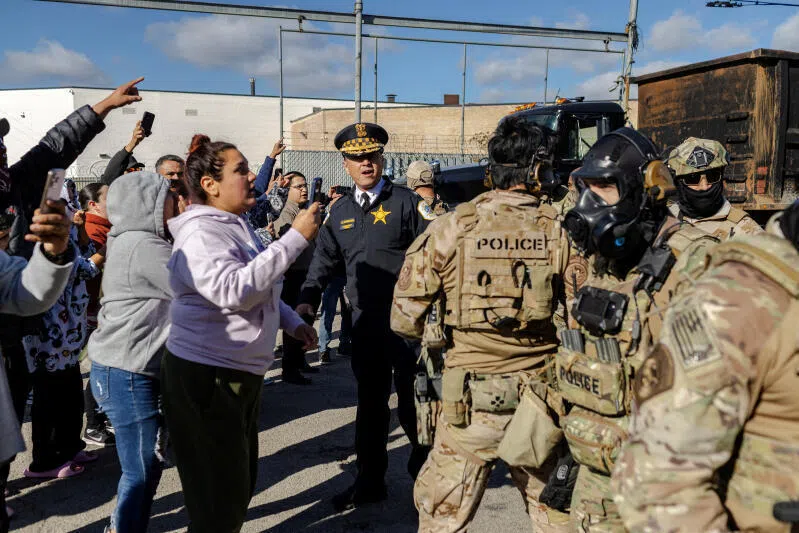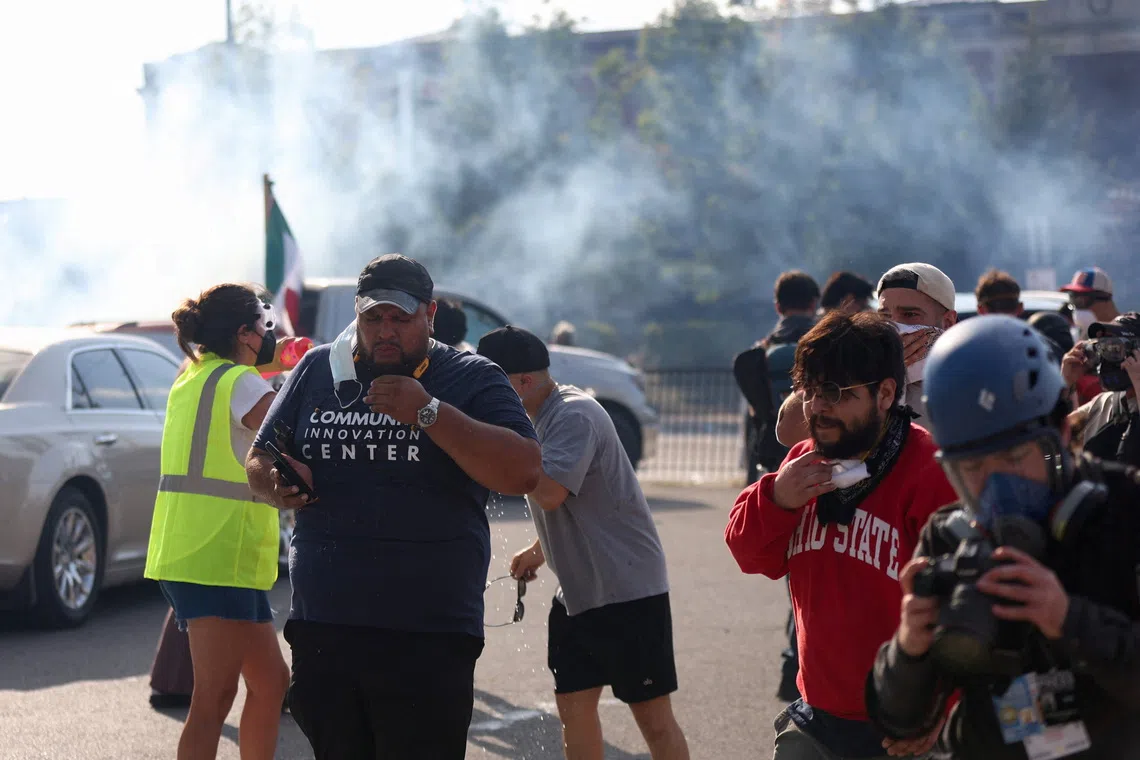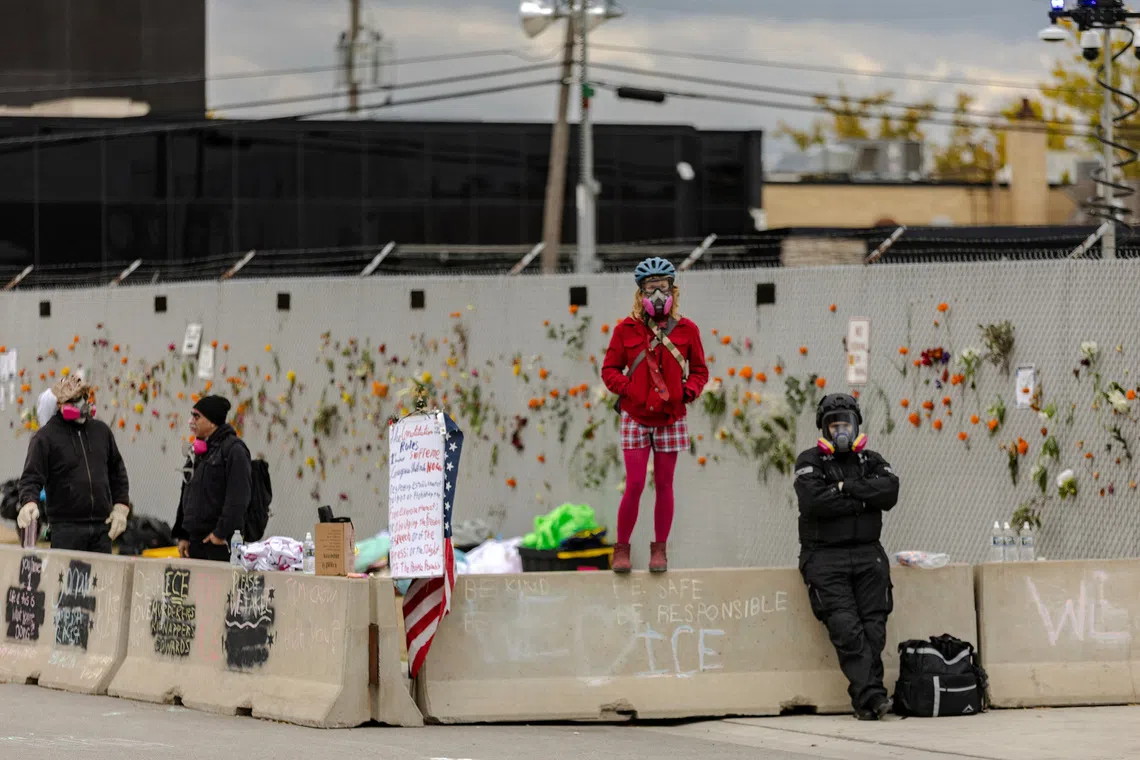‘We’re not a violent city’: Chicago locals take on ICE block by block
Sign up now: Get ST's newsletters delivered to your inbox

US federal agents confront community members during a stand-off in Chicago, Illinois, on Oct 23.
PHOTO: REUTERS
Follow topic:
CHICAGO – The immigration agents’ tear gas grenades clinked and then exploded against the concrete, shrouding the block in plumes of white gas. The dozen or so residents at the scene only screamed louder.
“We don’t want you here,” yelled Ms Rae Lindenberg. The 32-year-old, who works in marketing, ran out of her apartment when she heard the shrill sound of whistles. “Get out of our neighbourhood!”
The squad of agents had appeared in Lakeview in October, an upscale neighbourhood dotted with dog daycares, medical spas and vegan restaurants, hopping over a gate to chase down a construction worker who was handcuffed and shoved into a vehicle.
When Ms Courtney Conway, a 42-year-old lifelong Chicago resident, heard about the chase through Facebook groups and text message chains, she hopped on her bike to join the protesters.
“We are not a violent city. This is not a war zone, and I think these guys are terrorising us and trying to incite us,” she said. “We want them out. We want them to stop kidnapping our neighbours.”

Federal agents detain a man in a parking lot in the Avondale neighbourhood following a confrontation during immigration raids, in Chicago, Illinois, on Oct 25.
PHOTO: REUTERS
Creating a zone defence
Chicago, a city of 2.7 million, has long been known as a patchwork of close-knit neighbourhoods. And since the city took centre stage in President Donald Trump’s immigration crackdown in September, those neighbourhoods have mobilised against enforcement efforts, sometimes block by block.
That hyperlocal effort, spun off into dozens of chats on social platforms, has helped create a type of zone defence that – activists say – has slowed down immigration agents and, in some cases, forced them to withdraw without making an arrest.
Asked for comment, Department of Homeland Security (DHS) assistant secretary for public affairs Tricia McLaughlin said: “Our officers are highly trained and in the face of rioting, doxxing and physical attacks, they have shown professionalism. They are not afraid of loud noises and whistles.”
Over 3,000 people have been detained in Chicago since early September, according to DHS.
In Facebook groups and on Signal chats, tens of thousands of residents regularly crowdsource information on immigration agents’ last-known locations, neighbourhoods being targeted that day and – importantly – the licence plates, makes and models of the rental cars used by agents, which can change daily. Some ICE-spotting Facebook pages in Chicago have up to 50,000 members.
US Immigration and Customs Enforcement (ICE) and US Customs and Border Protection (CBP) agents prowling city streets in unmarked cars are often trailed by drivers honking their horns and cyclists blowing their whistles on an almost daily basis.
In some neighbourhoods, confrontations between CBP and ICE agents and protesters have grown increasingly heated. Immigration agents have tear-gassed at least five neighbourhoods in the past month, according to a Reuters tally, crashed their car into another vehicle at least once, arrested protesters trailing immigration agents, used Tasers on people during violent arrests, pointed guns at people and shot two people, including one fatally.

Demonstrators react to tear gas during a stand-off with US Immigration and Customs Enforcement and federal officers in the Little Village neighbourhood of Chicago, Illinois, on Oct 4.
PHOTO: REUTERS
The Cook County Department of Public Health said it does not track injuries sustained during confrontations with federal agents, and five city hospitals called by Reuters said they had not treated any protesters.
In October, US District Judge Sara Ellis directed agents to use body cameras and issue two warnings to protesters before using tear gas in a case brought by protesters, clergy and journalists.
Helicopter watch groups
Hours after the confrontation in the Lakeview neighbourhood, dozens of parents stood guard outside a school in Bucktown, another North Side neighbourhood favoured by families and young professionals, after hearing that ICE and border patrol officers were in the area.
Some parents set up an informal checkpoint next to the school to check cars for immigration enforcement agents.

Protesters stand outside the Broadview ICE facility in Chicago, Illinois, on Nov 1.
PHOTO: REUTERS
And in Little Village, one of the city’s biggest Latino enclaves, businesses and residents locked their doors after activists warned them of approaching ICE and border patrol vehicles and, at one point, surrounded vehicles to prevent them from making arrests.
“The community defended the neighbourhood today,” said Mr Baltazar Enriquez, president of the Little Village Community Council.
Some protesters specialise in watching out for Black Hawk helicopters the agents use to surveil neighbourhoods, which do not appear on flight-tracking apps and are often a harbinger of a raid.
On a recent Saturday morning, Mr Brian Kolp, an attorney and former prosecutor, ran out of the house in his pajamas when word spread throughout the Old Irving Park neighbourhood that immigration agents in balaclavas had grabbed a worker and a protester and shoved them into their car. Other residents came out in Halloween costumes.
“People were yelling, and it was chaos,” said Mr Kolp. Soon after, he said, agents tossed tear gas grenades into the street and left. REUTERS

